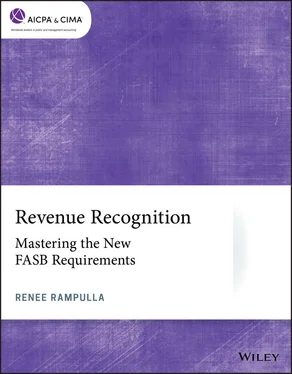Longo Technologies learns that Sutra Inc. has lost access to credit and its major customers and thus the customer’s ability to pay significantly deteriorates.
Longo Technologies concludes that it is unlikely that Sutra Inc. will be able to make any further royalty payments for ongoing usage of the patent.
As a result of the significant change in facts and circumstances, Longo Technologies reassesses whether collectability is probable and determines that the criteria has not been met because it is no longer probable that they will collect the consideration to which they will be entitled.
Longo Technologies ceases to recognize any further revenue associated with Sutra Inc.’s future usage of its patent.
Longo Technologies accounts for any impairment and additional credit loss on the existing receivable in accordance with other appropriate FASB ASC topics.
In year three when Longo Technologies learned that Sutra Inc. had lost access to credit and its major customers thereby significantly impacting their ability to pay the royalties, they reassessed that the collectability was no longer probable and ceased recognizing any future revenue associated with Sutra Inc.’s usage of its patent.
1 When a contract with a customer does not meet the five criteria and an entity receives consideration from the customer, the entity should recognize the consideration received as revenue only when:The entity has no remaining obligations to transfer goods or services to the customer, and all, or substantially all, of the consideration promised by the customer has been received by the entity and is non-refundable.The contract has been terminated, and the consideration received from the customer is refundable.The entity maintains control of the goods or services to which the consideration that has been received.The entity continues to transfer goods or services to the customer and the consideration received from the customer is non-refundable.
An entity should combine two or more contracts if the contracts were entered into at or near the same time with the same customer or related parties of the customer, if at least one of the following applies:
The contracts are negotiated as a package with a single commercial objective.
The amount of consideration in one contract depends on the price or performance of the other contract.
The goods or services are a single performance obligation.
Although not all inclusive, the following are some examples of when an entity should possibly consider combining separate contract with the same customer, keeping in mind that judgment is required because additional facts or different circumstances could result in a different conclusion.
Entities that provide engineering and construction services in separate contracts with the same customer, whose contracts are issued at or near the same time, may need to combine these separate contracts if the two contracts are for the design and building of a single capital asset and would be deemed a single performance obligation had they been in a single contract; therefore, these contracts should likely should be combined.
Educational institutions will need to determine if tuition and housing (or any other contracts entered into with the student) are contracted together in a single contract or in separate contracts. If entered into at or near the same time with the same student, specifically, if the contracts are negotiated as a package with a single commercial objective, the amount of consideration to be paid in one contract depends on the price or performance of the other contract, or if the services promised in the contracts are a single performance obligation, then the educational institution would combine the contracts. When making the determination of whether to combine contracts for tuition and housing, the educational institution would need to consider whether a discount (for example, financial aid) has been provided in a bundled arrangement. If the single commercial objective criterion has not been met, then the educational institution would treat the contracts as separate contracts and apply the guidance in FASB ASC 606 to each separate contract.
1 Indicators of a combined contract include:The contracts are entered into at or near the same time and have a single commercial objective.The contracts have different commercial objectives.The amounts of consideration in the two contracts are independent of each other.The customer receives a discount as a result of an existing relationship.
 Connected concepts: Practical point for management
Connected concepts: Practical point for management
The following are few considerations for management when identifying a contract with a customer:
Is there a formal or informal policy in place to approve and modify contracts with customers? Does that policy differ based on contract types?
Are there controls around both the approval and modification of contracts with customers?
Is there a need to engage expert legal advice to determine whether a contract with a customer is legally enforceable and/or has commercial substance?
At the inception of the contract, how has management determined that they will collect substantially all of the consideration they are entitled to?
How does management identify contracts that should be combined?
Has management elected the use of the portfolio approach? If so, how did management determine which contracts with customers have similar characteristics?
Can the judgments and assumptions used when identifying a contract with a customer be supported and are they documented? Is that documentation and support sufficient enough for the company’s auditors?
 Connected concepts: Practical point for small and medium-sized private companies
Connected concepts: Practical point for small and medium-sized private companies
Unlike larger companies, many private companies do not have the staff nor do the resources to tackle FASB ASC 606. Those private companies should consider reaching out to their auditors to learn if their auditors can provide non-attest services, providing those services do not impair their auditors’ independence, or seek the help of third parties skilled in the application of FASB ASC 606.
1 1 Exercise fact pattern originated from paragraphs 95–98 of FASB ASC 606-10-55.
2 2 Exercise fact pattern originated from FASB ASC 606-10-55-98.
3 3 Exercise fact pattern originated from paragraphs 99–101 of FASB ASC 606-10-55.
4 4 Example fact pattern originated from paragraphs 106–109 of FASB ASC 606-10-55.
Chapter 3 Identifying The Performance Obligations in the Contract
Learning objectives
Identify the definition of a performance obligation.
Identify promises of goods or services in a contract with a customer.
Identify when a good or service is distinct within the context of a contract with a customer.
The core principle of the revenue recognition standard is that an entity should recognize revenue to depict the transfer of goods or services to customers in an amount that reflects the consideration to which the entity expects to be entitled in exchange for those goods or services.
In order to achieve the core principle of the revenue standard, an entity should be able to perform the following five steps:
Step 1: Identify the contract with a customer
Читать дальше

 Connected concepts: Practical point for management
Connected concepts: Practical point for management










